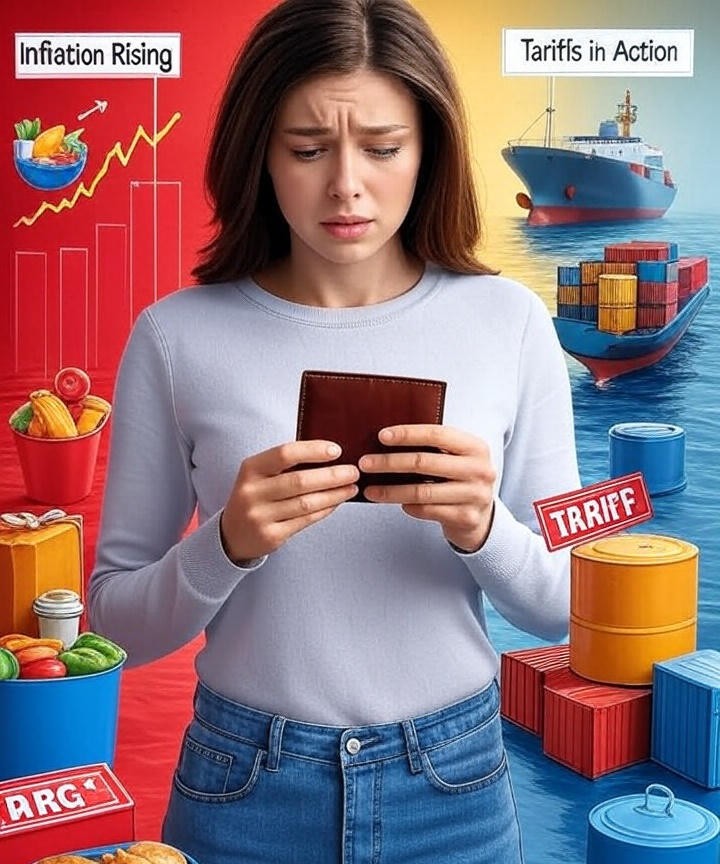Introduction
Inflation in the United States has climbed to its highest level since February 2025. One of the major reasons for this rise is the new tariffs introduced by former President Donald Trump. These tariffs have made many everyday goods more expensive for Americans. While the government may earn as much as $300 billion from these tariffs this year many people are starting to feel the pressure of rising prices.

What Is Inflation?
Inflation is when prices of goods and services go up over time. For example if a loaf of bread cost $2 last year and now it costs $2.20 that’s inflation. A small amount of inflation is normal in a growing economy. But too much inflation makes it harder for people to afford basic things like groceries, fuel and rent.
Right now inflation in the U.S. has reached its highest point since early 2025. This is concerning for families, businesses and investors alike.
What Are Tariffs?
Tariffs are taxes that the government puts on goods imported from other countries. For example if the U.S. imports cars or steel from another country it may charge a tax (tariff) on those items.
The idea behind tariffs is to protect American companies by making foreign goods more expensive. This way people may choose to buy American made products instead.
Former President Trump has used tariffs as a tool many times before. In 2025 he introduced more tariffs on goods from countries like China, Mexico and the European Union. These new taxes have made imported goods more costly and that’s affecting inflation.
How Tariffs Are Raising Prices
When a tariff is added to a product, the price usually goes up. Companies that import goods often pass the extra cost on to consumers. For example:
- A 30% tariff on electronics could raise the price of smartphones, laptops and TVs.
- A 20% tariff on auto parts could make it more expensive to fix or buy a car.
- Tariffs on food items like cheese, wine or coffee could raise your grocery bill.
These extra costs build up across many sectors making everything from home appliances to clothing more expensive.
The Impact on Inflation
Because tariffs make goods more expensive they directly impact inflation. As companies pay more for imported materials and products they raise prices to keep their profits stable. This cycle causes inflation to go up.
In July 2025 inflation rose faster than expected. Economists believe that Trump’s tariffs are a major factor behind this rise. The prices of imported goods and related services have increased and everyday Americans are feeling the impact at gas stations, grocery stores and online retailers.
Government Revenue from Tariffs
While tariffs are raising prices they are also bringing in a lot of money for the U.S. government. According to the U.S. Treasury chief the government could collect as much as $300 billion in tariff revenue this year.
This money goes into government funds and can be used for public services like infrastructure defense or debt repayment. However critics say this comes at the cost of higher living expenses for consumers and businesses.
So while the government gains revenue many families lose purchasing power.
How Businesses Are Affected
Small and medium businesses are also feeling the heat. Many rely on imported goods or raw materials. With tariffs raising costs businesses are forced to either:
- Increase prices (risking customer loss)
- Absorb the costs (reducing profits) or
- Cut expenses (sometimes laying off workers or reducing quality).
Retailers, manufacturers, and even farmers are impacted especially if their products involve parts or ingredients from other countries.
Global Trade Tensions
Tariffs don’t just affect the U.S. They can spark trade wars when other countries respond by adding tariffs of their own.
For example if the U.S. adds tariffs on European wine the EU might add tariffs on American whiskey. These back and forth taxes can damage international trade and lead to higher costs globally.
They can also harm relationships with trade partners reduce export opportunities and hurt industries that depend on selling products overseas.
What It Means for You
As inflation rises the cost of living goes up. Here’s how you might feel the impact:
- Higher prices at the grocery store, clothing shops and online retailers.
- Increased rent and transportation costs.
- Lower savings value your money does not go as far as before.
- Possible job losses if businesses reduce staff due to higher expenses.
It’s important to adjust your budget and try to save more during times of high inflation. Look for deals, consider buying local products and track your spending.
What Can Be Done?
Economists and policymakers are debating how to handle this situation. Some possible actions include:
- Revising tariffs to reduce pressure on prices.
- Monetary policy adjustments by the Federal Reserve (like changing interest rates).
- Support programs for low-income families to deal with rising living costs.
- Negotiating trade agreements to ease tensions with other countries.
Ultimately balancing tariff revenue with inflation control is a tricky job for the government.
Conclusion
The recent rise in inflation is a serious concern for the U.S. economy. While tariffs are bringing in big revenue for the government, they are also causing prices to rise sharply for everyday Americans. Families are spending more businesses are under pressure and international trade is becoming more complex.
As the situation unfolds it’s important to stay informed and make smart financial choices. The government will need to find a way to balance protecting local industries with keeping inflation under control because in the end what matters most is how much we all can afford.
